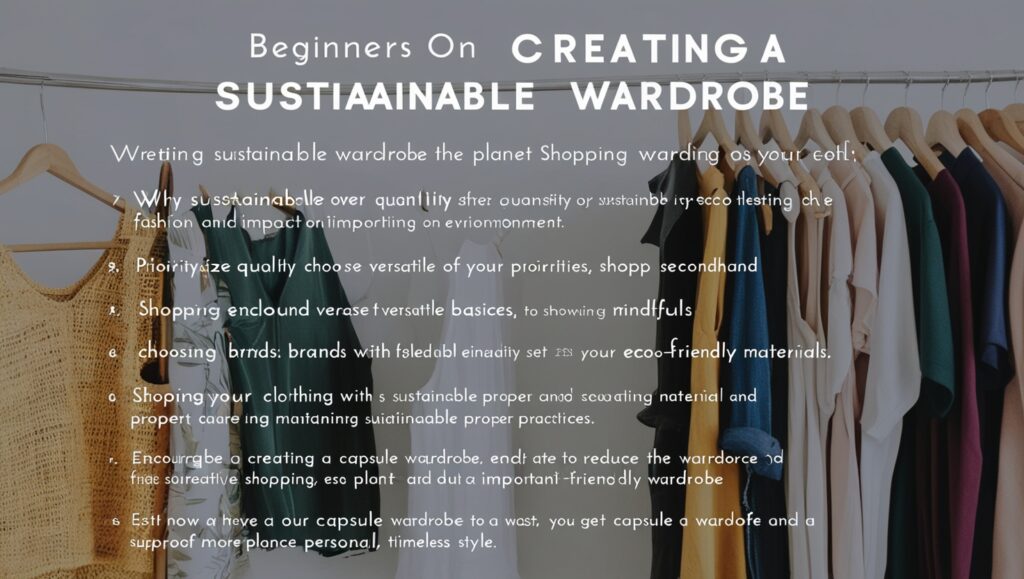How to Build a Sustainable Wardrobe a Beginners Guide
Building a sustainable wardrobe is more than just a trend; it’s a commitment to making mindful choices that benefit both your lifestyle and the environment. Adopting sustainable fashion practices doesn’t mean you have to sacrifice style or spend excessively. Instead, it involves thoughtful curation, high-quality pieces, and adopting habits that allow you to make the most of what you own. Here’s a beginner’s guide to help you start your journey toward a more eco-friendly, stylish wardrobe.
1. Understand What Makes Fashion Sustainable
Sustainable fashion focuses on minimizing environmental impact while promoting ethical practices. This means choosing clothes made from eco-friendly materials, supporting brands with fair labor practices, and buying items designed to last. By understanding these principles, you can make more informed decisions that support sustainability in every piece you purchase.
2. Embrace the “Less is More” Mindset
A sustainable wardrobe doesn’t need to be vast. Instead of focusing on quantity, aim for quality. Start by decluttering your current wardrobe to identify pieces you actually wear and love. Let go of items you haven’t worn in over a year, and consider donating or selling them to give them a new life. This step not only helps clear your closet but also encourages a more minimalist mindset that values meaningful pieces over fast fashion.
3. Invest in Versatile Basics
Essentials form the foundation of a sustainable wardrobe. Invest in versatile, high-quality basics that you can mix and match, like well-fitted jeans, neutral t-shirts, blazers, and little black dresses. Look for timeless pieces that won’t go out of style, ensuring you can wear them season after season without feeling outdated.
4. Opt for Sustainable Materials
Choosing the right fabrics is a major part of building an eco-friendly wardrobe. Prioritize materials like organic cotton, linen, Tencel, and recycled fabrics, which have lower environmental footprints compared to conventional cotton or synthetic fibers. Brands now label their materials more transparently, making it easier to identify sustainable fabrics. Additionally, look for certifications like GOTS (Global Organic Textile Standard) or Fair Trade to ensure ethical production practices.
5. Shop Secondhand and Vintage
Secondhand shopping is a great way to extend the life of clothing that might otherwise end up in a landfill. Thrift stores, vintage shops, and online resale platforms are treasure troves for finding unique pieces at affordable prices. Plus, shopping secondhand supports the circular fashion economy by reducing the demand for new clothing production.
6. Choose Brands That Prioritize Sustainability
As sustainability becomes a priority for many consumers, more fashion brands are focusing on ethical and eco-friendly practices. Look for brands that are transparent about their materials, manufacturing processes, and labor practices. Some sustainable brands also offer repair services or buy-back programs to help extend the life of their products.
7. Learn Basic Clothing Care and Repair
The longer your clothes last, the more sustainable your wardrobe becomes. Learn simple care practices like hand-washing delicate items, air drying instead of using a dryer, and storing clothes properly to maintain their shape. Basic sewing skills are also valuable, allowing you to repair minor damage like loose buttons or small tears instead of discarding items that could still be worn.
8. Prioritize Timeless Over Trendy
Fashion trends come and go, but classic pieces remain in style. To build a sustainable wardrobe, focus on timeless designs and colors that you know will always suit you, like neutral tones, classic cuts, and functional styles. By avoiding overly trendy items, you can prevent the urge to frequently update your wardrobe and reduce unnecessary consumption.
9. Create a Capsule Wardrobe
A capsule wardrobe is a carefully curated selection of clothes that mix and match easily, offering countless outfit options with fewer items. Building a capsule wardrobe encourages thoughtful purchases and ensures every piece serves a purpose. Start by selecting a limited number of pieces in neutral shades, adding accent colors that complement your style. This approach helps reduce closet clutter and makes dressing easier every day.
10. Stay Mindful When Shopping
Before making a new purchase, pause to ask yourself a few questions: Do I really need this? Does it align with my style? Will I wear it frequently? By shopping mindfully, you can avoid impulse purchases that end up unused. When you do buy, aim for high-quality, durable pieces that align with your sustainable wardrobe goals.
Final Thoughts
Building a sustainable wardrobe takes time, patience, and a shift in mindset, but the rewards are well worth it. Not only does it allow you to reduce waste and lessen your environmental footprint, but it also encourages a more personal, intentional sense of style. Remember, it’s not about overhauling your closet overnight; rather, it’s about making gradual changes that align with your values and lead to a more conscious approach to fashion. By investing in quality pieces, embracing timeless style, and choosing eco-friendly options, you’re not just creating a wardrobe—you’re making a positive impact on the world of fashion and beyond.

